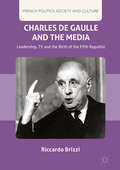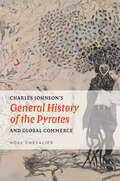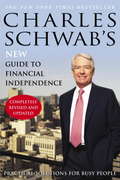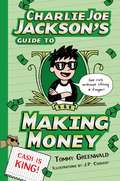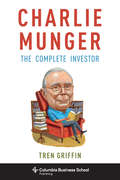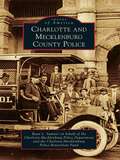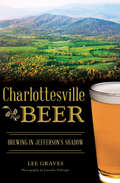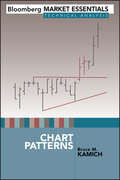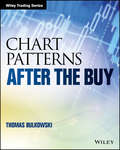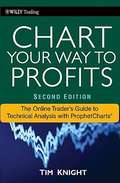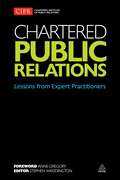- Table View
- List View
Charlene Barshefsky (B)
by James K. Sebenius Rebecca HulseDetails former U.S. Trade Representative Charlene Barshefsky's strategic and tactical approach to surmounting the barriers laid out in the (A) case.
Charles De Gaulle and the Media: Leadership, TV and the Birth of the Fifth Republic (French Politics, Society and Culture)
by Riccardo BrizziThis book explores Charles De Gaulle's use and strict control of television between 1958 and 1969, highlighting the association between charismatic power and television with regards to legitimizing the Gaullist leadership and determining an evolution towards presidentialism during the Fifth Republic. A protagonist of European political history of the twentieth century, Charles de Gaulle was a pioneer in the use of mass media: in the Second World War he had earned the nickname of G#65533;n#65533;ral-micro due to his reliance on radio communication; in 1958 he then started an substantive and fruitful use of television, which some of his opponents labelled as 'telecracy'. From difficult beginnings, where he followed the advice of publicity and communication experts, through his masterful TV appearances during the dramatic moments of the Algerian War, to the presidential campaign of 1965 and the crisis of May 1968, the author paints a compelling fresco of de Gaulle as the first TV leader in contemporary European history. The book will appeal to students and scholars interested in the fields of French politics, political communication and political leadership.
Charles Johnson's "General History of the Pyrates" and Global Commerce (Transits: Literature, Thought & Culture, 1650-1850)
by Noel ChevalierA bestseller upon its publication in 1724, Charles Johnson’s General History of the Pyrates shaped public perceptions of piracy with its portraits of such legendary figures as Blackbeard, Mary Read, Anne Bonny, and Bartholomew Roberts. Yet despite influencing everything from Treasure Island to Peter Pan, Johnson’s book has yet to be taken seriously as a literary work in its own right. This study explores how General History of the Pyrates was at the heart of early eighteenth-century British debates about commerce, colonialism, and law. Examining how pirates are depicted as both monsters and Great Men, Noel Chevalier untangles the contradictions within a Britain emerging as a colonial superpower, where ruthlessness and ambition were both feared and praised. Traveling the high seas to plunder treasure from foreign lands, pirates were not so different from the British capitalists who built fortunes from resource extraction, the plantation economy, and the transatlantic slave trade. Connecting the work to later books like Gulliver’s Travels and The Beggar’s Opera that satirized the era and its power-hungry prime minister Robert Walpole, Chevalier shows how the pirate became an iconic figure in 1720s Britain, a time of cold-hearted capitalism and rapacious colonial expansion.
Charles River Jazz Festival
by George WuCharles River Jazz Festival must decide whether to press a compact disk (CD) of Friday's jazz performance for sale on Saturday and Sunday. The idea to press CDs is novel, so there is considerable uncertainty about how receptive customers will be. The festival must decide whether to press CDs only on Friday or pay for an option to press them on Friday and Saturday. A simulation is performed to help estimate Saturday and Sunday CD demand. One input of the simulation is a regression relating Saturday and Sunday attendance to Friday attendance and weekend weather conditions. The case illustrates how several different quantitative techniques--decision analysis, regression, and simulation--can be integrated in an analysis of a managerial decision problem. Provides practice in decision analysis; illustrates use of simulation and regression in obtaining probability estimates.
Charles Schwab & Co., Inc.: The
by John A. Quelch Laura WinigSchwab management is evaluating the success of the recently launched "Talk to Chuck" advertising campaign. This campaign aims to differentiate Schwab in the cluttered financial services marketplace. Test market results facilitate discussion of advertising objectives, message strategy, media selection, and performance measures.
Charles Schwab & Co., Inc.: The
by John A. Quelch Laura WinigSchwab management is evaluating the success of the recently launched "Talk to Chuck" advertising campaign. This campaign aims to differentiate Schwab in the cluttered financial services marketplace. Test market results facilitate discussion of advertising objectives, message strategy, media selection, and performance measures.
Charles Schwab Corp. (A)
by Nicole Tempest F. Warren McFarlanA look at the industrial restructuring in the brokerage industry made possible by e-commerce. Focuses the student's attention on the decision alternatives facing Charles Schwab, one of the industry leaders in January 1998. In a word, the challenge is "Do they slash prices to meet competition from companies like E-Trade or do they stand still?"
Charles Schwab Corp. (A)
by F. Warren Mcfarlan Nicole TempestA look at the industrial restructuring in the brokerage industry made possible by e-commerce. Focuses the student's attention on the decision alternatives facing Charles Schwab, one of the industry leaders in January 1998. In a word, the challenge is "Do they slash prices to meet competition from companies like E-Trade or do they stand still?"
Charles Schwab Corp. (B)
by F. Warren Mcfarlan Nicole TempestCatches the situation facing Charles Schwab Corp. in late August 1999 in the dramatically changing brokerage industry. Their bold moves in January 1998 have created a new industry competitive pattern and provoked aggressive response by companies like Merrill Lynch.
Charles Schwab Corp.: Introducing a New Brand
by Rajiv Lal David KironAs the financial services industry converges, how should Charles Schwab, widely known as a discount brokerage firm, position its brand? This case presents elements of the company's overall brand strategy--including brand assets, choice of target audience, and media message.
Charles Schwab in 2002
by F. Warren Mcfarlan Lynda M. Applegate Jamie LadgeDetails the evolution of the Charles Schwab business model, from its founding in 1975 to October 2002. The protagonist, David Pottruck, is faced with re-inventing the firm as a full-service brokerage at a time of tremendous industry instability as the industry reels from the effects of deregulation, consolidation, global economic downturn, and investor lack of confidence.
Charles Schwab's New Guide to Financial Independence
by Charles R. Schwab"There are dozens of primers on investing, but Schwab's is straightforward and carefully organized. . . . The glimmers of his personal life are gems. . . . By now, Schwab is a financial brand name, and the lessons from his rich life make for good reading--and good investing." --Suze Orman, author of The 9 Steps to Financial Freedom. The biggest risk in investing is doing nothing. In the updated edition of this New York Times bestseller, Charles Schwab presents clear and simple lessons that will give readers the confidence they need to start down the road to financial independence. Schwab, one of the most trusted gurus in American investing, explains all the basics in a clear, easy-to-understand way. This revised edition completely updates the book to take into consideration the substantial changes and fluctuations in the market in recent years. A significant amount of new material has been added, including a valuable section on performance monitoring, a key strategy that enables investors to measure the performance of their portfolios against objective benchmarks. Using this excellent book, investors will learn how to: * Define and set investment goals * Prepare an investment plan, put it into action, and update it regularly * Plan for their children's education * Cope effectively with the ups and downs of the market * Plan for a comfortable retirement. (From the Trade Paperback edition.)
Charles Veillon, S.A. (A)
by Aldo Sesia Lynn Sharp PaineThe top management team at Charles Veillon, a Swiss mail-order company, is considering whether to work with a human rights organization to monitor the labor practices of its suppliers. A particular concern is avoiding child labor and other forms of workplace coercion.
Charlie Joe Jackson's Guide to Making Money (Charlie Joe Jackson #4)
by J. P. Coovert Tommy GreenwaldCharlie Joe's weekly allowance just isn't cutting it and he desperately needs money to buy a Botman, the latest gadget to sweep his middle school. Only catch is, he wants to earn the money by doing the least amount of work possible. After several failed attempts, including a near disastrous day of dog-walking, Charlie Joe hatches a plan to throw his own bar mitzvah (no gifts please—checks only) even though he's not Jewish. Hilarity ensues when throwing a fake coming-of-age party turns out to be much harder than it looks.
Charlie Munger: The Complete Investor (Columbia Business School Publishing)
by Tren GriffinCharlie Munger, Berkshire Hathaway's visionary vice chairman and Warren Buffett's indispensable financial partner, has outperformed market indexes again and again, and he believes any investor can do the same. His notion of "elementary, worldly wisdom"—a set of interdisciplinary mental models involving economics, business, psychology, ethics, and management—allows him to keep his emotions out of his investments and avoid the common pitfalls of bad judgment.Munger's system has steered his investments for forty years and has guided generations of successful investors. This book presents the essential steps of Munger's investing strategy, condensed here for the first time from interviews, speeches, writings, and shareholder letters, and paired with commentary from fund managers, value investors, and business-case historians. Derived from Ben Graham's value-investing system, Munger's approach is straightforward enough that ordinary investors can apply it to their portfolios. This book is not simply about investing. It is about cultivating mental models for your whole life, but especially for your investments.
Charlotte Beers at Ogilvy & Mather Worldwide (A)
by Herminia Ibarra Nicole SackleyExamines Beer's actions on assuming leadership of Ogilvy & Mather Worldwide, the world's sixth largest advertising agency, during a period of rapid industry change and organizational crisis. Focuses on how Beers, the first outsider CEO, engages and leads a senior team through a vision formulation process. Chronicles closely the debates among senior executives struggling to reconcile creative, strategic, and global vs. local priorities. Sixteen months later, with a vision statement agreed upon, Beers faces a series of implementation problems. Turnaround has begun, but organizational structures and systems are not yet aligned with the firm's new direction. Concludes as Beers must decide how to work best with her senior team to achieve alignment in 1994.
Charlotte Beers at Ogilvy & Mather Worldwide (B)
by Herminia Ibarra Nicole SackleyUpdates CEO Beers' progress two years after her initiation of a massive organizational change effort. Designed as an in-class handout.
Charlotte and Mecklenburg County Police (Images of America)
by Charlotte-Mecklenburg Police Department Ryan L. SumnerFor nearly a century and a half, police in Charlotte and Mecklenburg County have displayed tremendous courage and sacrifice in the execution of their duty, adapted to social and cultural changes within the American South, and increasingly embraced sophisticated methods and revolutionary advances in technology to meet the challenges posed by criminals and a violent culture. Images of America: Charlotte and Mecklenburg County Police highlights the rich history of two departments that consolidated in 1993 as the Charlotte-Mecklenburg Police Department.
Charlottesville Beer: Brewing in Jefferson's Shadow (American Palate)
by Lee Graves Jennifer PullingerPossibly the region’s first craft brewer, Thomas Jefferson grew hops and created his own small-batch brews at his home at Monticello. His brewing, however, was only the beginning. Charlie Papazian got his start homebrewing at the University of Virginia and went on to become a founder of the craft brewing movement. The city was not spared the fervent debate over prohibition, and the area went dry well in advance of the country in 1907. The Brew Ridge Trail set the standard for regional attractions focused on brewery destinations and sees thousands trek through the beautiful countryside enjoying libations. National award–winning breweries like Devils Backbone, Starr Hill and Three Notch’d elevated Charlottesville to a center of craft beer. Author Lee Graves offers a history and guide to brewing in scenic Charlottesville.
Chart Patterns (Bloomberg Financial #41)
by Bruce M. KamichThe Bloomberg Market Essentials: Technical Analysis series covers the key elements of the most widely used technical analysis tools. Using these fast-track resources, traders can come up to speed quickly on each method—what it is, how it works, and how to use it. The third book in this series, Chart Patterns, gives traders the first step toward applying one of the oldest and most widely used tools in the market. Flags, head-and-shoulders patterns, double bottoms, and more are detailed to help the trader know when a breakout is coming or when a trend is continuing. Bruce Kamich is a highly respected voice in the technical analysis community, coauthoring the widely read Morgan Stanley Smith Barney Daily Technical Market Letter publication.
Chart Patterns: After the Buy
by Thomas N. BulkowskiTake chart patterns beyond buy triggers to increase profits and make better trades Chart Patterns: After the Buy goes beyond simple chart pattern identification to show what comes next. Author and stock trader Thomas Bulkowski is one of the industry's most respected authorities in technical analysis; for this book, he examined over 43,000 chart patterns to discover what happens after you buy the stock. His findings are detailed here, to help you select better buy signals, avoid disaster, and make more money. Bulkowski analyzed thousands of trades to identify common paths a stock takes after the breakout from a chart pattern. By combining those paths, he discovered the typical routes a stock takes, which he calls configurations. Match your chart to one of those configurations and you will know, before you buy, how your trade will likely perform. Now you can avoid potentially disastrous trades to focus on the big winners. Each chapter illustrates the behavior of a specific pattern. Identification guidelines help even beginners recognize common patterns, and expert analysis sheds light on the period of the stock's behavior that actually affects your investment. You'll discover ideal buy and sell setups, how to set price targets, and more, with almost 370 charts and illustrations to guide you each step of the way. Coverage includes the most common and popular patterns, but also the lesser-known ones like bad earnings surprises, price mirrors, price mountains, and straight-line runs. Whether you're new to chart patterns or an experienced professional, this book provides the insight you need to select better trades. Identify chart patterns Select better buy signals Predict future behavior Learn the best stop locations Knowing the pattern is one thing, but knowing how often a stop will trigger and how often you can expect a stock to reach its target price is another matter entirely--and it impacts your trade performance immensely. Chart Patterns: After the Buy is the essential reference guide to using chart patterns effectively throughout the entire life of the trade.
Chart Your Way To Profits
by Timothy KnightA cutting-edge guide to turning technical analysis into trading success, Chart Your Way to Profits, Second Edition shows you how to use the powerful technology available online in conjunction with technical analysis to assess markets and make the most profitable trading decisions possible. In the book, author Tim Knight discusses the key aspects of technical analysis and reveals how to design your own charts and indicators in a way that enables you to easily monitor the markets and make solid trading decisions. This new edition discusses a wider range of technical tools within ProphetCharts and shows you how to evaluate and compare industry sectors and groups of stocks to identify the best trading opportunities. Features many new technical tools for tracking individual stocks Illustrates how to use the highly-rated online application ProphetCharts to create state-of-art, customized graphs Helps hone your own analysis skills through hundreds of real-world examples Written in a straightforward and accessible manner, Chart Your Way to Profits, Second Edition not only explains technical analysis, but also provides readers with examples demonstrating how effective technical analysis can identify highly profitable trades.
Charter Schools and Their Enemies
by Thomas SowellA leading conservative intellectual defends charter schools against the teachers' unions, politicians, and liberal educators who threaten to dismantle their success.The black-white educational achievement gap -- so much discussed for so many years -- has already been closed by black students attending New York City's charter schools. This might be expected to be welcome news. But it has been very unwelcome news in traditional public schools whose students are transferring to charter schools. A backlash against charter schools has been led by teachers unions, politicians and others -- not only in New York but across the country. If those attacks succeed, the biggest losers will be minority youngsters for whom a quality education is their biggest chance for a better life.
Chartered Public Relations
by Stephen WaddingtonPublished as part of the 2015 tenth anniversary celebrations of the Chartered Institute of Public Relations (CIPR)'s Royal Charter, Chartered Public Relations is an anthology of modern-day public relations best practice from Chartered Public Relations practitioners. It makes a valuable contribution to the advancement of public relations thinking worldwide by addressing the most current discussions on topics such as qualification of results in public relations, internal communications, freedom of information, global communication and more.Chartered Public Relations discusses in detail, among other things, the shift to the open organisation, the application of best practice in different markets and the impact of the globalisation of markets in public relations. Featuring contributions from public relations experts from a plethora of industries and companies including Specsavers, Thomson Reuters, Pielle Consulting and the University of Cambridge, it will inspire a new wave of professionals to take up the challenge of achieving Chartered PR Practitioner status.

